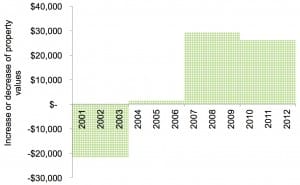New publication: The value of restoring urban drains to living streams
Waterway restoration work can involve substantial costs, and if water sensitive urban design concepts such as the creation of living streams are to be widely adopted, it is important to demonstrate that the benefits from restoration are greater than the costs.
Dr James Fogarty, Dr Fan Zhang and Dr Maksym Polyakov, researchers in the CRC for Water Sensitive Cities project Valuation of economic, social and ecological costs and benefits (Project A1.2), discussed their research in a new industry note on the amenity and economic value of a living stream in Perth, Western Australia.

A study of the benefits of the Bannister Creek living steam project in the suburb of Lynwood in Perth showed there is “a positive net effect on house prices in the neighbourhood of the living stream”, the authors said.
“While there was an initial negative impact on local house prices during the construction stage of the project, after the natural wetland ecosystem has established, the median home within 200m of the restoration site increased in value by $17,000 to $26,000 above the trend increase in house values in the area.”
Urban streams have been affected by vegetation clearing, channelisation, and the creation of open drains over the decades, resulting in decreased water quality and loss of native habitat and biodiversity.
The research showed the growing recognition of the importance of living streams’ amenity and ecological functions and that creating “fully functioning natural waterways and wetland ecosystems” was shown to have positive effects on the community according to a new CRCWSC for Water Sensitive Cities Industry Note.
Click here to view the report.